Korky Toilet
Repair Kit Review & Install Guide
How to fix a leaking, running or noisy
toilet with the Lavelle Korky 4010PK repair kit including a consumer's
opinion.
By Paul B. Michaels Author & Photographer Auto Mechanic Since 1989 |
||
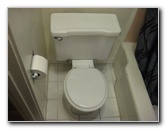 Old 1960's Home Toilet |
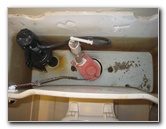 Rubber Flapper Falling Apart |
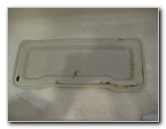 Remove Ceramic Tank Lid |
| We
recently moved in to a "new" place that was built over 50 years ago.
Just one of the many small problems that I discovered while living
in this "charming" and "historic" home is that the toilet
doesn't work properly most of the time. Some of the issues included water leaking from the tank to the bowl, the flapper wouldn't seat correctly after flushing and the fill valve would constantly be turning on to partially re-fill the tank due to the leaks. The constant noise from the toilet, always having to "jiggle" the flush handle and the high water bills were driving me crazy. Since I've used the Fluidmaster Kit in the past, I decided to try the Korky Universal Complete Repair Kit # 4010PK made by Lavelle. I got it from Amazon. The Fluidmaster 400AK kit includes a new flush handle, which the Korky does not. |
||
|
|
||
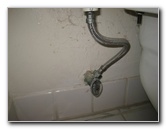 Toilet Water Supply Valve |
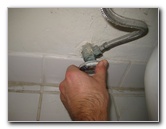 Close Valve Clockwise |
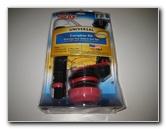 Korky 4010PK Kit |
| Even though the
Korky 4010PK kit doesn't come with a new flush handle, the reviews on Amazon
totaled 4.5 stars out of 5 while the Fluidmaster 400AK kit got a lower score
of 3.5 stars. All of the parts in the kit seemed to be high quality plastic, rubber and metal hardware especially considering the low price. A two sided instruction paper was included with illustrations and clearly laid out steps. The first few steps for installing the kit are to remove the tank lid, close the water supply valve by turning it clockwise until it stops and then flush the toilet to drain the water from the tank. |
||
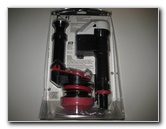 |
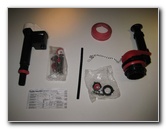 |
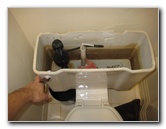 Flush Toilet - Empty Tank |
| I separated the kit
in to the major parts while looking over the instructions.
They included the fill valve assembly, flush valve assembly, foam rubber gasket (between tank and toilet bowl), a bag of mounting screws with rubber and metal washers, the rubber fill tube, and two plastic nuts for securing the water supply line to the tank. |
||
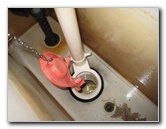 Old Flapper Valve Broke |
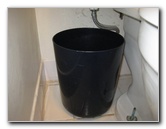 Trash Can Below Tank |
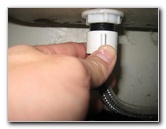 Twist Off Water Supply Hose |
| I couldn't help but
laugh out loud when the old disintegrated flapper valve ripped off when I
flushed it for the very last time. It was perfect timing for me to replace
everything. The next step is to place a bucket or small trash can below where the water supply hose attaches to the underside of the tank. Twist off the plastic nut that holds the hose in place by turning it counter clockwise. |
||
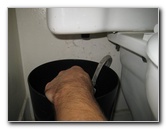 Insert Hose In Bucket |
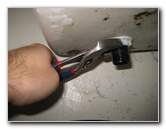 Loosen Fill Valve Nut |
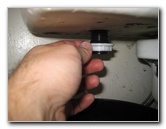 Spinning Off Nut |
| Allow the remaining
water in the tank to drain out in to the bucket. Loosen the plastic fill valve mounting nut by hand or with a pair of pliers and turn it counter clockwise to remove it. |
||
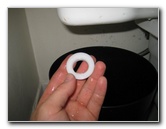 Fill Valve Nut Removed |
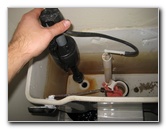 Pull Out Old Fill Valve |
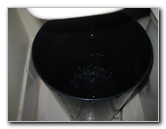 Water Draining From Tank |
| Pull out the old fill valve and allow the water to drain from the tank in to the bucket. | ||
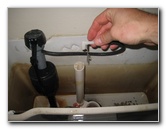 Disconnect Tube From Flush |
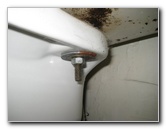 Toilet Tank Mounting Screws |
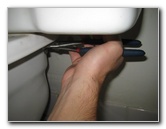 Loosen Counter Clockwise |
| Pull the tube off
the flush valve and throw away the old fill valve. Move to the bottom of the tank and loosen the two nuts on the mounting screws by turning them counter clockwise with a pair of pliers. |
||
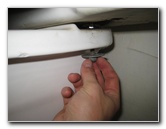 Spin Off Mounting Nuts |
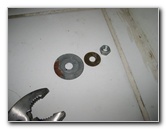 Nut & Washers Removed |
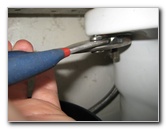 Loosen Other Nut |
| Throw away the old nuts and washers. | ||
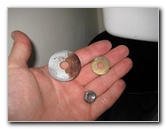 |
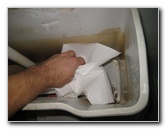 Soak Up Remaining Water |
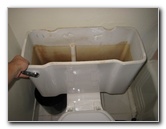 Lift Toilet Tank Off Bowl |
| Remove any left
over water in the bottom of the tank with a sponge or a towel. Carefully lift the tank off the toilet bowl and rest the back side on top of the seat lid. |
||
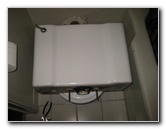 Rest Toilet Tank On Seat |
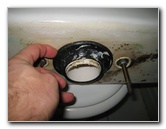 Pull Off Old Sponge Gasket |
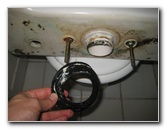 Sponge Gasket Removed |
| Pry off the old rubber sponge gasket from the bottom of the tank and discard it. | ||
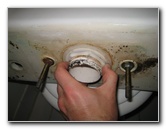 Twist Off Flush Valve Nut |
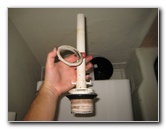 Pull Out Old Flush Valve |
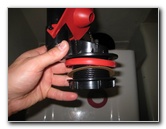 New Flush Valve |
| Twist off the old flush valve nut by turning it counter clockwise. If the nut is on too tight to be loosened by hand, you may need a large plumbing wrench or adjustable pliers. | ||
|
|
||
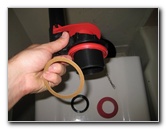 Tan Chipboard Washer |
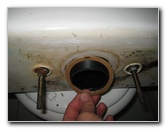 Washer On New Valve |
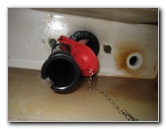 Orientate New Flush Valve |
| Remove the black
plastic collar nut and tan chipboard (feels like hard cardboard) washer from
the bottom of the new flush valve. Insert the flush valve in to the tank with the flapper facing towards the fill valve hole at an angle. (See Picture # 53.) Place the chipboard washer on to the flush valve threads at the bottom of the tank. |
||
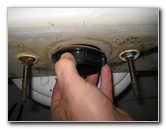 Hand Tighten Plastic Nut |
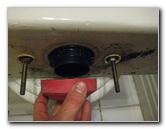 Push On New Gasket |
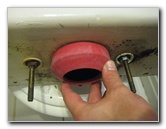 Gasket Flush With Tank |
| Spin on the black
plastic collar nut to the bottom of the new flush valve and tighten it by
hand. Do not over tighten the nut or use a wrench to tighten it. Push the wider end of the new red rubber sponge gasket on to the bottom of the new flush valve. Make sure that the gasket is flush against the bottom of the tank with the narrower end pointing out towards you. |
||
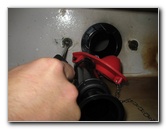 Hold Screw In Place |
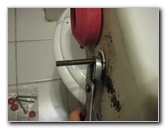 Loosen Tank Nuts |
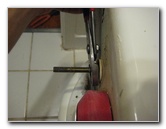 |
| Hold the old tank mounting screws in place with a flathead screwdriver while loosening the nuts with a pair of pliers or adjustable wrench. | ||
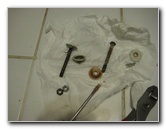 Old Tank Hardware Removed |
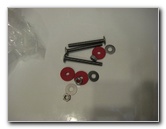 New Tank Hardware |
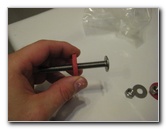 Rubber Washers On Screws |
| Pull the old screws
and washers out of the tank and discard them. Push the new rubber washers all the way to the top of the new screws. |
||
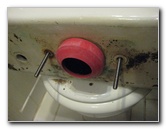 New Screws Installed |
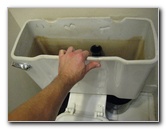 Lower Tank On Bowl |
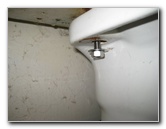 Attach Washer & Nut |
| Insert the new
screws in to the bottom of the tank. Carefully lower the tank down on to the toilet while lining up the two screws with the holes at the rear of the bowl. Attach a metal washer and nut to each of the mounting screws. |
||
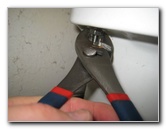 Slowly Tighten Both Sides |
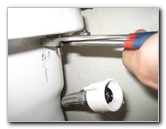 |
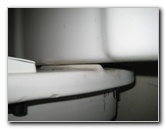 Tank Tight Against Bowl |
| Hold down the tank
with one hand while slowly tightening the two nuts.
Once the tank just barely makes contact with the toilet bowl, very carefully continue tightening the nuts until the tank no longer wobbles when you touch it.
|
||
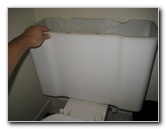 Check Tank Doesn't Wiggle |
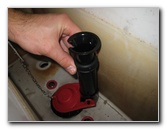 Loosen Flush Valve Nut |
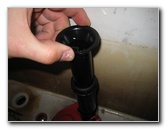 Adjust To Above Water Line |
| Loosen the flush
valve adjustment nut by turning it counter clockwise. Raise the top of the overflow tube until it is 3/4 of an inch above the water line and about 1" below the flush level nut. |
||
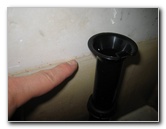 3/4" Above Water Line |
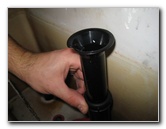 Tighten Adjustment Nut |
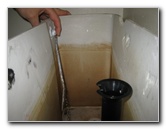 1" Below Flush Lever Nut |
| Tighten the overflow tube adjustment nut by turning it clockwise. | ||
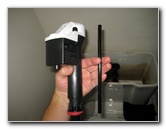 New Fill Valve & Tube |
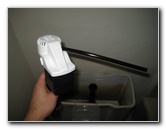 Attach Tube To Top Valve |
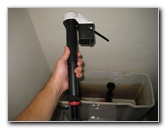 Unlock & Extend Valve Body |
| Attach the fill
tube to the black plastic nozzle on the side of the new fill valve. Unlock the large adjustment tube on the new fill valve by turning it counter clockwise about 1/4 turn. Extend the tube all the way out. |
||
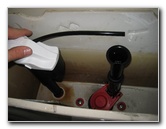 Line Up Two Valves |
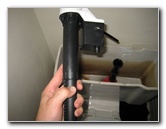 Twist To Lock Fill Valve |
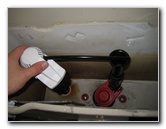 Tube Direct To Fill Valve |
| Line up the two
valves so that the lower white corner of the fill valve is at the same
height as the top of the overflow tube. Once the fill valve has been adjusted to the correct height, lock it by gently twisting the lower tube 1/4 turn clockwise until you hear a click or "snap" sound. Re-insert the new fill valve with the small fill hose facing directly towards the overflow tube. |
||
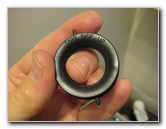 "This Side Up" Nut |
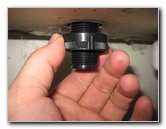 Tighten Fill Valve Nut |
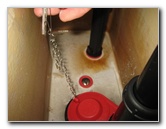 Attach Chain - Minimal Slack |
| Locate the black
plastic fill valve nut with the words "This Side Up" printed on one side. Twist on the nut at the bottom of the tank to secure the new fill valve in place. Only hand tighten the nut until it is snug. Attach the chain from the flapper valve to the flush lever with a very small amount of slack. |
||
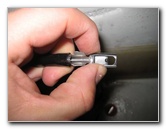 Push Metal Clip In Tube |
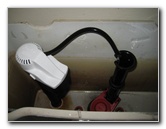 Attach Hose To Fill Valve |
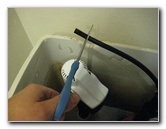 Trim Excess Tube Off |
| Push the round end
of the metal clip in to the end of the fill hose and slide the other side on
to the flat cut out section of the overflow tube on the flush valve. If the fill hose kinks or is just too long, trim off a short section so that it only has a small curve in it. |
||
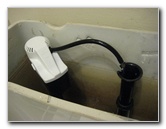 Filler Tube Installed |
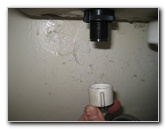 Water Supply Line Nut |
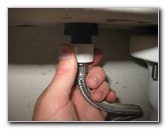 Hand Tighten Plastic Nut |
| The tip of the
filler hose should be at the very top of the overflow tube and not be
positioned down in to the tube. Some types of water supply lines will be able to use the new plastic nut in the kit. Our water supply line was a braided stainless steel one, so I just re-used the old nut. Spin on the water supply line and tighten the plastic nut to just past hand tight. Do not use a wrench to tighten the nut or over tighten it since you may damage the rubber washer and cause a leak. Turn on the water supply by turning the valve all the way open in the counter clockwise direction until it stops. Make sure that the valve is fully open to firmly seat the rubber washer inside of it and prevent a leak. |
||
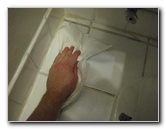 Clean Water Off Floor |
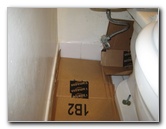 Put Down Paper / Cardboard |
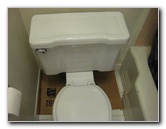 Leaky Toilet Fixed! |
| Clean up any
spilled water around the toilet. Place some newspapers or cardboard below the toilet tank so you can quickly see if there are any leaks over the next few days. Enjoy your quiet toilet and lower water
bills!
Overall, I found the Korky 4010PK kit to be relatively easy to install and it seems to be working great. If I had realized that it didn't come with a new flush handle, I may have chosen the Fluidmaster kit. Although I don't like that the Fluidmaster kit I previously used required that I cut the overflow tube with a hack saw, which can be a problem if you cut off too much. Plus I prefer the more advanced fill valve in the Korky kit compared to the older design floating cylinder on the Fluidmaster fill valve. For more, check out my other
Home Repair &
Maintenance Guides. |
||
| If you found this guide to be helpful,
please consider making a small donation by clicking on the PayPal.com
"Donate" button located to the right of this paragraph. Thank you!
(Note: I am not a registered charity. Donations are not tax deductible.) |

